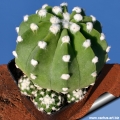




Your support is critical to our success.
Accepted Scientific Name: Echinopsis ancistrophora Speg.
Anales Mus. Nac. Buenos Aires ser. 3, 4: 492. 1905
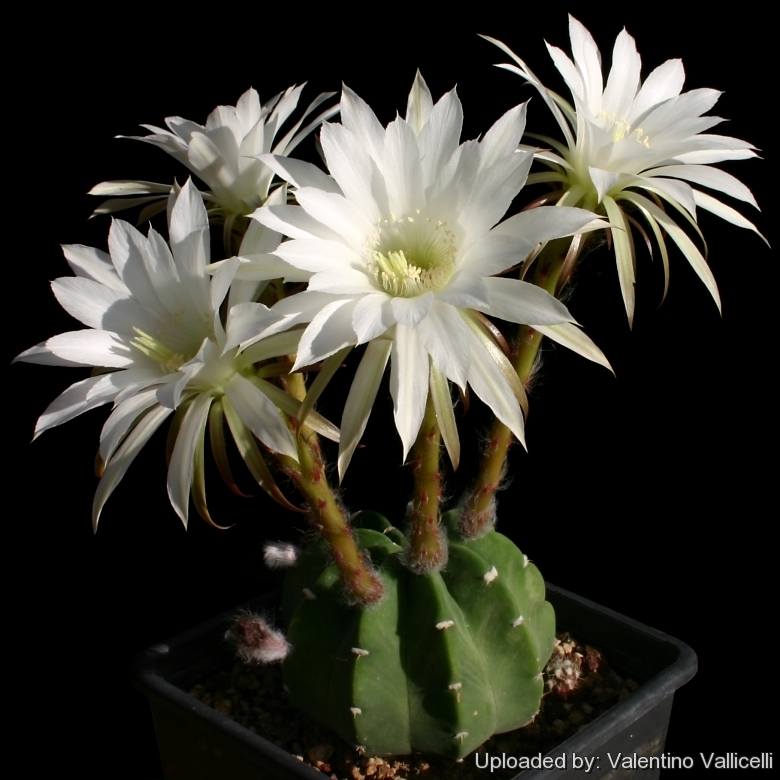
This Echinopsis is almost spineless or with very short cream spines and produces gorgeous, night-blooming, white fragrant flowers up to 22 cm long.
Origin and Habitat: Bolivia (Santa Cruz, Tarija, Chuquisaca) and (maybe) Paraguay.
Altitude: 600-1800 metres above sea level.
Habitat: This species grows in many habitat types, such as grasslands, shrublands, and forests. The major threats to this species are urbanization, agriculture and extraction for ornamental use.
Synonyms:
- Echinopsis subdenudata Cárdenas
Echinopsis ancistrophora Speg.
Anales Mus. Nac. Buenos Aires ser. 3, 4: 492. 1905
Synonymy: 31
- Echinopsis ancistrophora Speg.
- Cereus pasacanus (F.A.C.Weber ex Rümpler) F.A.C.Weber
- Mesechinopsis ancistrophora (Speg.) Y.Itô
- Pseudolobivia ancistrophora (Speg.) Backeb. ex Krainz
- Echinopsis ancistrophora var. hamatacantha (Backeb.) Rausch
- Echinopsis hamatacantha Backeb.
- Mesechinopsis hamatacantha (Backeb.) Y.Itô
- Pseudolobivia hamatacantha (Backeb.) Backeb.
- Echinopsis ancistrophora var. megalocephala (Rausch) Rausch
- Echinopsis rauschii var. megalocephala Rausch
- Lobivia calorubra var. megalocephala (Rausch) Rausch
- Echinopsis ancistrophora var. polyancistra (Backeb.) Rausch
- Echinopsis polyancistra Backeb.
- Mesechinopsis polyancistra (Backeb.) Y.Itô
- Pseudolobivia polyancistra (Backeb.) Backeb.
- Echinopsis ancistrophora var. rubriflora Rausch
- Echinopsis leucorhodantha Backeb.
- Mesechinopsis leucorhodantha (Backeb.) Y.Itô
- Pseudolobivia leucorhodantha (Backeb.) Backeb. ex Krainz
- Echinopsis lobivioides Backeb.
- Echinopsis pelecyrhachis var. lobivioides (Backeb.) H.Friedrich
- Lobivia grandiflora var. lobivioides (Backeb.) Rausch
- Mesechinopsis lobivioides (Backeb.) Y.Itô
- Pseudolobivia lobivioides Backeb. ex Krainz
- Pseudolobivia pelecyrhachis var. lobivioides (Backeb.) Backeb.
- Echinopsis pelecyrhachis Backeb.
- Mesechinopsis pelecyrhachis (Backeb.) Y.Itô
- Pseudolobivia pelecyrhachis Backeb. ex Krainz
- Echinopsis subdenudata Cárdenas
- Echinopsis subdenudata f. cristata aurea hort.
- Echinopsis subdenudata f. cristata hort.
Echinopsis ancistrophora subs. arachnacantha (Buining & F.Ritter) Rausch
Lobivia 3: 140. 1977
Synonymy: 22
- Echinopsis ancistrophora subs. arachnacantha (Buining & F.Ritter) Rausch
- Echinopsis arachnacantha (Buining & F.Ritter) H.Friedrich
- Lobivia arachnacantha Buining & F.Ritter
- Echinopsis ancistrophora var. densiseta (Rausch) Rausch
- Echinopsis arachnacantha subs. densiseta (Rausch) M.Lowry
- Echinopsis arachnacantha var. densiseta (Rausch) Friedrich
- Lobivia arachnacantha var. densiseta Rausch
- Echinopsis ancistrophora var. kratochviliana (Backeb.) Rausch
- Echinopsis kratochviliana Backeb.
- Neolobivia kratochviliana (Backeb.) Y.Itô
- Pseudolobivia kratochviliana Backeb.
- Echinopsis ancistrophora var. sulphurea (R.Vásquez) Rausch
- Echinopsis arachnacantha subs. sulphurea (R.Vásquez) Lowry
- Echinopsis arachnacantha var. sulphurea (R.Vásquez) G.D.Rowley
- Lobivia arachnacantha var. sulphurea R.Vásquez
- Echinopsis ancistrophora var. torrecillasensis (Cárdenas) Rausch
- Echinopsis arachnacantha subs. torrecillasensis (Cárdenas) M.Lowry
- Echinopsis arachnacantha var. torrecillasensis (Cárdenas) Friedrich
- Echinopsis torrecillasensis Cárdenas
- Lobivia arachnacantha var. torrecillacensis (Cárdenas) Buining
- Pseudolobivia torrecillasensis (Cárdenas) Backeb.
- Echinopsis arachnacantha var. vallegrandensis Rausch
Echinopsis ancistrophora subs. cardenasiana (Rausch) Rausch
Lobivia 3: 140. 1977
Synonymy: 3
- Echinopsis ancistrophora subs. cardenasiana (Rausch) Rausch
- Echinopsis cardenasiana (Rausch) Friedrich
- Lobivia cardenasiana Rausch
Echinopsis ancistrophora subs. pojoensis (Rausch) Rausch
Lobivia 3: 140. 1976
Synonymy: 6
- Echinopsis ancistrophora subs. pojoensis (Rausch) Rausch
- Lobivia calorubra var. pojoensis (Rausch) Rausch
- Lobivia pojoensis Rausch
- Echinopsis ancistrophora var. grandiflora (Rausch) Rausch
- Echinopsis rauschii var. grandiflora (Rausch) H.Friedrich
- Lobivia pojoensis var. grandiflora Rausch
ENGLISH: Night-blooming Hedge-hog, Easter Lily Cactus
LITHUANIAN (Lietuvių): Plikasis echinopsis
Description: Echinopsis subdenudataSN|1041]]SN|17377]] is a globular, almost spineless or with very short cream spines that produces splendid night-blooming, white fragrant flowers up to 22 cm long. It is generally included within (as a synonym of) Echinopsis ancistrophoraSN|1041]]SN|1041]], suggesting that there is not really a fundamental difference between the two. The key difference by which this species was separated, namely: its much shorter spines (less than 2 mm long) almost concealed among the felt of the areoles appears to fall within the natural variation of Echinopsis ancistrophoraSN|1041]]SN|1041]] and it should be synonymized with the latter. It is at most a race of Echinopsis ancistrophoraSN|17377]]SN|1041]], but it still has a value for a collector because they identify plants with particular characters.
Stem: Solitary or offsetting from near the base, globose, grey-green, depressed apically, 5-8 cm tall, 7-12 cm in diameter (often elongate and up to 30 cm high in cultivation)
Ribs: 8 to 12, very acute, slightly notched.
Areoles: Small, cream coloured, transversely elliptical, to 1.5 cm apart.
Spines:Almost spineless or with very short cream or greyish brown spines, often hidden by areolar wool. Central spine one, directed upward, to 2 mm long. Radial spines 3-7, swollen
basally, to 1.5 mm long.
Flowers: These cacti produce gorgeous, night-blooming flowers borne near the stem tips. They are fragrant, white (or very light pink), narrow funnel-shaped, with long, slightly curved tubes 15-22 cm long. Old plant may have many flowers at a time.
Blooming season: This species blooms from late spring to all summer long, the flowers open on the morning of the first day and remain opened all the night long but last only one day in full beauty, at the second day they start to wither.
Subspecies, varieties, forms and cultivars of plants belonging to the Echinopsis ancistrophora group
- Echinopsis ancistrophora Speg.: has flowers of varying colors. Distribution: From south of Salta, Argentina to the border into southern Bolivia.
 Echinopsis ancistrophora subs. arachnacantha (Buining & F.Ritter) Rausch: has smaller clustering stems with yellow to yellow-orange flowers. Distribution: Region of Samaipata, Santa Cruz, Bolivia.
Echinopsis ancistrophora subs. arachnacantha (Buining & F.Ritter) Rausch: has smaller clustering stems with yellow to yellow-orange flowers. Distribution: Region of Samaipata, Santa Cruz, Bolivia. Echinopsis ancistrophora subs. cardenasiana (Rausch) Rausch: has bright magenta to red flowers. Distribution: Tarija.
Echinopsis ancistrophora subs. cardenasiana (Rausch) Rausch: has bright magenta to red flowers. Distribution: Tarija. Echinopsis ancistrophora var. densiseta (Rausch) Rausch: has longer end denser spines than some of the others and flowers are red. Distribution: Vallegrande, Santa Cruz, Bolivia, just at east of var. vallegrandensis.
Echinopsis ancistrophora var. densiseta (Rausch) Rausch: has longer end denser spines than some of the others and flowers are red. Distribution: Vallegrande, Santa Cruz, Bolivia, just at east of var. vallegrandensis. Echinopsis ancistrophora subs. pojoensis (Rausch) Rausch: has larger stems and reddish flowers. Distribution: Pojo, Cochabamba, Bolivia.
Echinopsis ancistrophora subs. pojoensis (Rausch) Rausch: has larger stems and reddish flowers. Distribution: Pojo, Cochabamba, Bolivia.- Echinopsis ancistrophora var. sulphurea (R.Vásquez) Rausch
- Echinopsis ancistrophora var. torrecillasensis (Cárdenas) Rausch
 Echinopsis subdenudata Cárdenas: has a globose to elongate stems to up to 8 cm high with 8 to 12 -ribs. Almost spineless or with very short cream spines.
Echinopsis subdenudata Cárdenas: has a globose to elongate stems to up to 8 cm high with 8 to 12 -ribs. Almost spineless or with very short cream spines. Echinopsis subdenudata f. cristata aurea hort.: yellow mutant completely lacking chlorophyll pigment with fan shaped stems.
Echinopsis subdenudata f. cristata aurea hort.: yellow mutant completely lacking chlorophyll pigment with fan shaped stems.  Echinopsis subdenudata f. cristata hort.: is a very nice crested Echinopsis, easily recognizable for its almost spineless body.
Echinopsis subdenudata f. cristata hort.: is a very nice crested Echinopsis, easily recognizable for its almost spineless body.
Bibliography: Major references and further lectures
1) David R Hunt; Nigel P Taylor; Graham Charles; International Cactaceae Systematics Group. "The New Cactus Lexicon" dh books, 2006
2) Edward Anderson “The Cactus family” Timber Press, Incorporated, 2001
3) James Cullen, Sabina G. Knees, H. Suzanne Cubey "The European Garden Flora Flowering Plants: A Manual for the Identification of Plants Cultivated in Europe, Both Out-of-Doors and Under Glass" Cambridge University Press, 11/Aug/2011
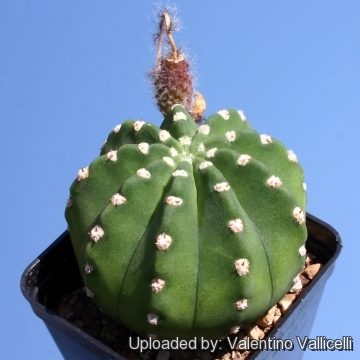
Echinopsis subdenudata Photo by: Valentino Vallicelli
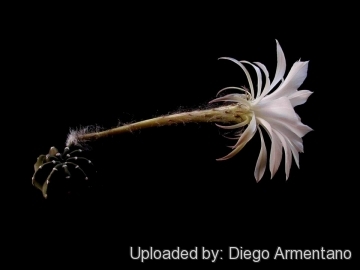
Echinopsis subdenudata Photo by: Diego Armentano
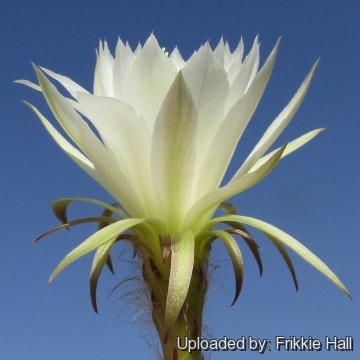
Echinopsis subdenudata Photo by: Frikkie Hall
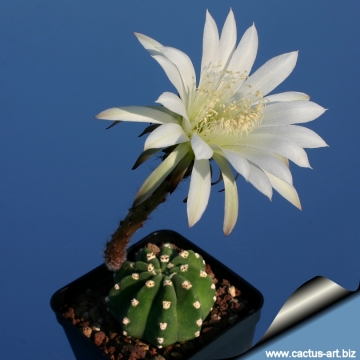
Echinopsis subdenudata Photo by: Cactus Art
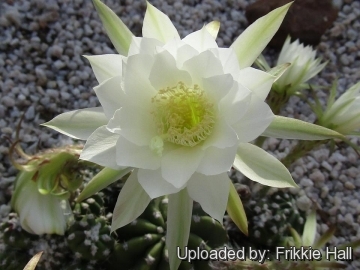
Echinopsis subdenudata Photo by: Frikkie Hall
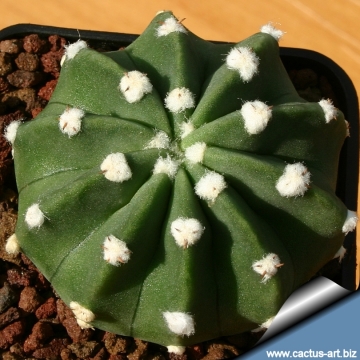
Echinopsis subdenudata Photo by: Cactus Art
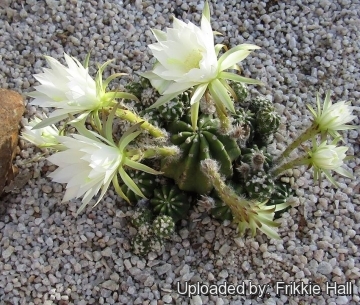
Echinopsis subdenudata Photo by: Frikkie Hall
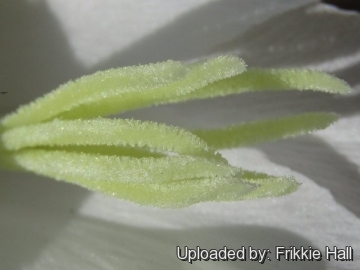
Echinopsis subdenudata Photo by: Frikkie Hall
Cultivation and Propagation: The Easter Lily cactus is a summer grower species that offers no cultivation difficulties. Water regularly in summer (but do not overwater ) needs good drainage and very porous soil, keep rather dry in winter. Feed with a high potassium fertilizer in summer. It is quite frost resistant if kept dry (hardy to -7° C). Need a bright exposure, full sun or half shade in summer.
Propagation: Direct sow after last frost, offsets.
| Your Actions | |
|---|---|
| Back to Echinopsis index | |
| Back to Cactaceae index | |
 |
Back to Cacti Encyclopedia index |
Privacy stantement - Terms and conditions - How to cite - About us - Feedback - Donate







